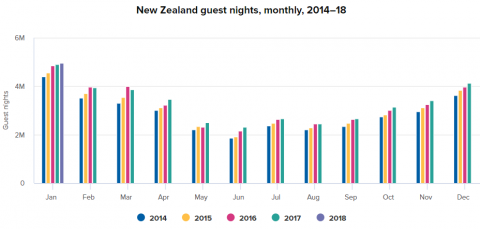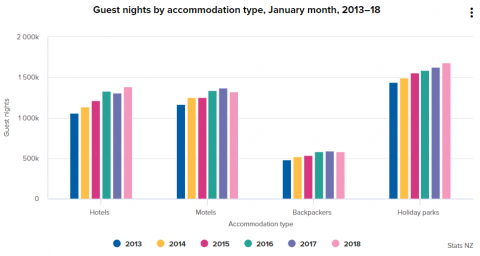New Zealand tourism breaking more records
Contact
New Zealand tourism breaking more records
Stats NZ has reported that guest nights spent in short-term accommodation reached record levels in January 2018 rising to 4.97 million, 1.4 percent higher than in January 2017.
Hotels and holiday parks were especially busy, with more international guest nights in January 2018. However, fewer New Zealanders stayed in motels than in January last year.
January is typically the height of the peak season for many accommodation operators, and usually the time when record highs are set.
“International guest nights also reached their highest-ever level in January, even as international visitor arrivals dipped slightly in the month,” accommodation statistics manager Melissa McKenzie said. “This may be because some people who arrived in 2017 stayed on in January.”

Source: Stats NZ
Of all accommodation types, hotel guest nights increased the most in January 2018, up 6.0 percent, boosted by both domestic and international guest nights. Guest nights spent in holiday parks increased 3.2 percent, driven by increased international guest nights.
Motels also benefited from record international guests, but had fewer Kiwis stay. Overall, motel guest nights dropped 3.4 percent from January 2017.
Guest nights spent in backpacker accommodation fell 2.3 percent from January 2017, with decreases for both international and domestic guest nights.

Source: Stats NZ
In the year ended January 2018, 39.53 million guest nights were spent in short-term commercial accommodation, 2.5 percent more than the previous January year and more than any other 12-month period.
Over the same period, international visitor arrivals numbered 3.73 million, 5 percent up on the January year before. New Zealand residents took 2.87 million trips overseas, up 9 percent.
The accommodation survey collects data for guests staying in short-term commercial accommodation such as hotels, motels, backpackers, and holiday parks. Hosted and private accommodation, such as bed and breakfasts and holiday homes, are excluded.
See also:
SKYCITY Auckland's CBD carpark with hotel development potential







